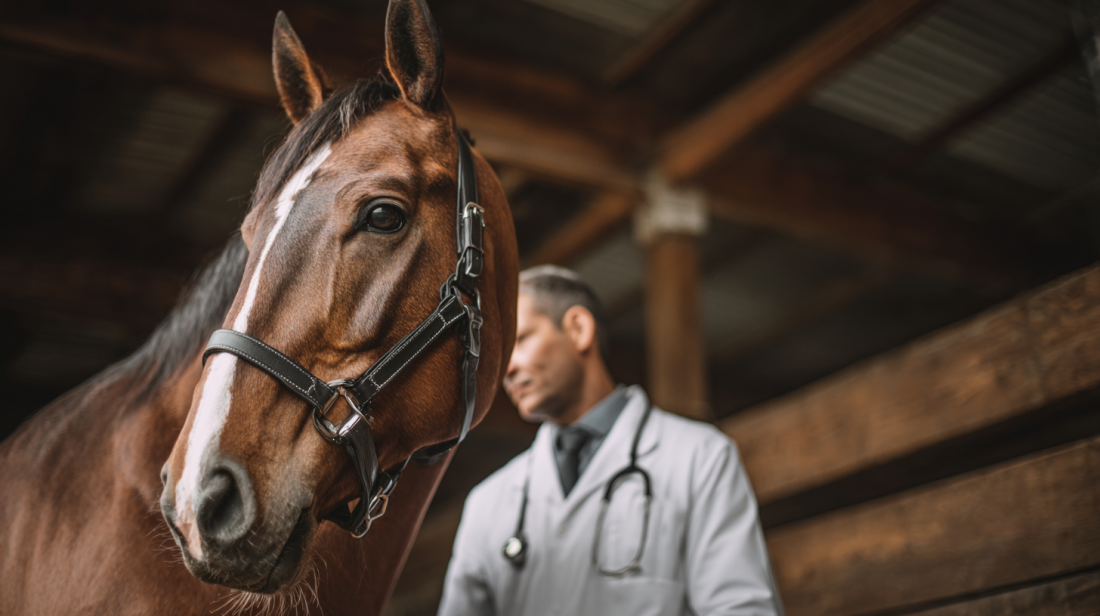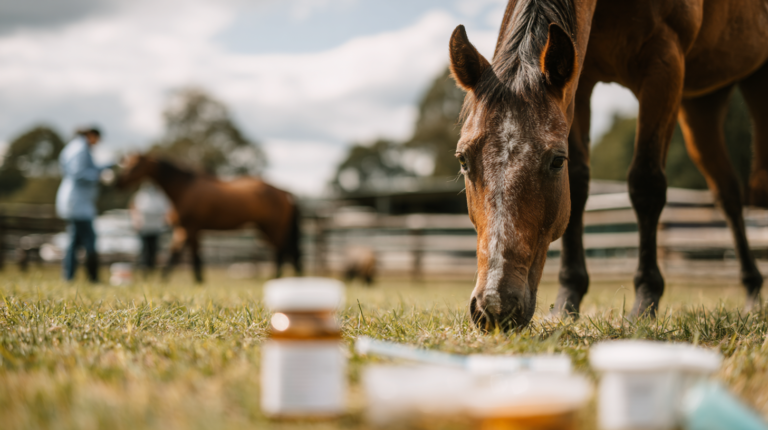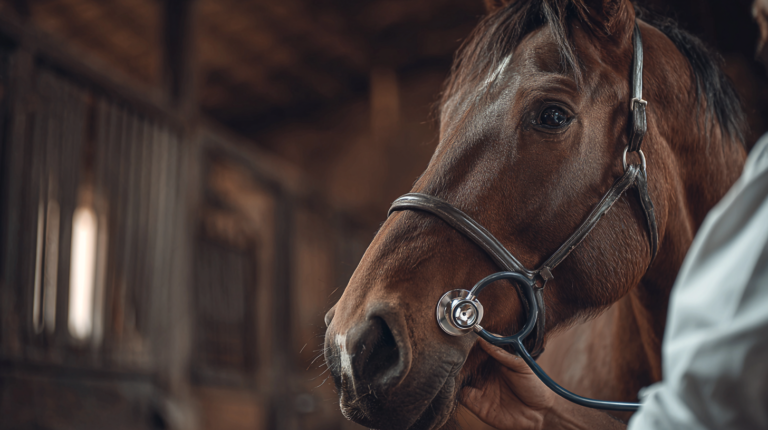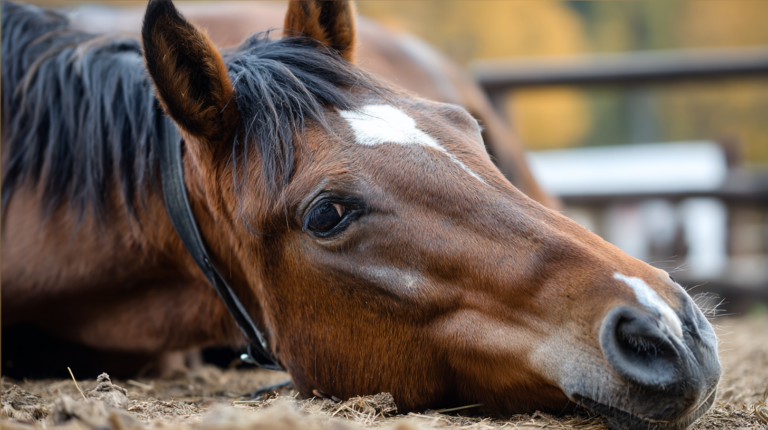Discover the 5 critical warning signs of vitamin toxicity in horses. Learn prevention tips, symptoms, and when to call your veterinarian from certified experts.
Table of Contents
When it comes to equine health, most horse owners understand the importance of proper nutrition and vitamin supplementation. However, what many don’t realize is that too much of a good thing can become dangerous. Vitamin toxicity in horses is a serious condition that can develop when these magnificent animals receive excessive amounts of certain vitamins, leading to potentially life-threatening complications.
Unlike humans, horses have unique metabolic requirements and sensitivities that make them particularly vulnerable to vitamin overdoses. The equine digestive system processes nutrients differently, and what might seem like a beneficial supplement boost can quickly cross the line into toxic territory. Understanding the warning signs of vitamin toxicity in horses isn’t just important—it’s essential for every responsible horse owner.
Recent veterinary studies indicate that vitamin toxicity cases in horses have increased by approximately 23% over the past five years, largely due to well-intentioned but misinformed supplementation practices. Dr. Sarah Mitchell, an equine nutritionist with over 15 years of experience, explains: “Horse owners often assume that if some vitamins are good, more must be better. This misconception has led to a concerning rise in hypervitaminosis cases that we’re seeing in our practice.”
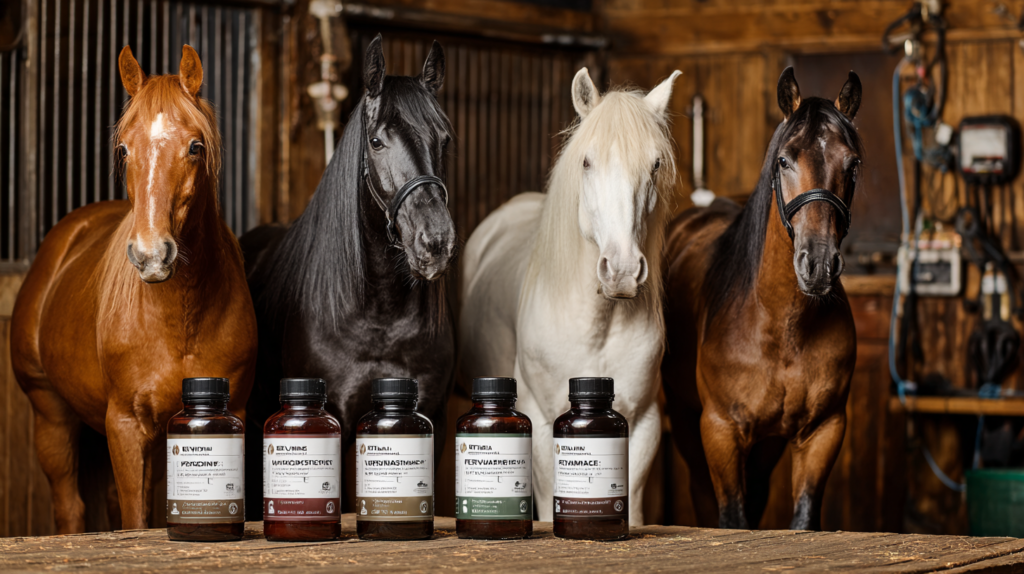
The financial and emotional cost of vitamin toxicity extends far beyond the initial treatment. Emergency veterinary care for severe cases can range from $3,000 to $15,000, not including long-term rehabilitation and potential permanent damage. More importantly, these conditions can significantly impact your horse’s quality of life, performance, and overall well-being.
This comprehensive guide will equip you with the knowledge to recognize the five critical warning signs of vitamin toxicity in horses, understand which vitamins pose the greatest risks, and implement prevention strategies that will keep your equine companion healthy and thriving.
Vitamin Toxicity Warning Signs in Horses
Click any row to highlight – Recognize these critical symptoms early
| Warning Sign Category | Specific Symptoms | Severity Level | Onset Timeline | Action Required |
|---|---|---|---|---|
| Gastrointestinal Distress | Colic, diarrhea, loss of appetite, excessive salivation | Critical | Hours to days | Immediate veterinary care |
| Skin & Coat Changes | Hair loss, skin lesions, dull coat, dermatitis | Moderate | Days to weeks | Veterinary assessment |
| Skeletal Problems | Joint swelling, lameness, bone deformities | Critical | Weeks to months | Immediate intervention |
| Neurological Symptoms | Tremors, coordination issues, behavioral changes | Critical | Days to weeks | Emergency veterinary care |
| Respiratory Issues | Labored breathing, exercise intolerance | Moderate | Days to weeks | Veterinary evaluation |
| Cardiovascular Signs | Irregular heartbeat, weakness, collapse | Critical | Hours to days | Emergency treatment |
Understanding Vitamin Toxicity in Equines
Vitamin toxicity, also known as hypervitaminosis, occurs when horses consume vitamins in amounts that exceed their body’s ability to process and eliminate them safely. While vitamins are essential nutrients that support various bodily functions, the principle of “more is better” simply doesn’t apply to equine nutrition.
Horses can experience two types of vitamin toxicity: acute and chronic. Acute toxicity develops rapidly after a single large dose or multiple high doses over a short period, while chronic toxicity builds gradually over weeks or months of excessive intake. Both forms can be equally dangerous, but chronic toxicity is often more insidious, as symptoms may not appear until significant damage has already occurred.
The most problematic vitamins for horses are the fat-soluble vitamins (A, D, E, and K), which the body stores in fatty tissues and the liver. Unlike water-soluble vitamins that are readily excreted through urine, fat-soluble vitamins accumulate in the body, making toxicity more likely with prolonged supplementation.
Vitamin A toxicity is particularly concerning in horses because it affects bone development, skin health, and reproductive function. Horses naturally convert beta-carotene from fresh grass into vitamin A, but many commercial feeds and supplements contain pre-formed vitamin A. When horses receive both natural and synthetic sources, toxicity can develop rapidly.
Vitamin D toxicity is equally serious, as it directly impacts calcium absorption and bone metabolism. Horses typically synthesize adequate vitamin D through sun exposure, making supplementation unnecessary and potentially dangerous. Excessive vitamin D can lead to calcification of soft tissues, kidney damage, and severe lameness.
The bioavailability of vitamins in horses also differs significantly from other animals. Factors such as the horse’s age, body condition, exercise level, and existing health conditions all influence how vitamins are absorbed and metabolized. Young, growing horses and senior horses are particularly susceptible to vitamin toxicity due to their altered metabolic rates and reduced ability to process excess nutrients.
The Five Critical Warning Signs
1. Gastrointestinal Distress and Digestive Issues
The digestive system is often the first to show signs of vitamin toxicity in horses. This occurs because the gastrointestinal tract serves as the primary site of vitamin absorption and is directly exposed to excessive nutrient levels. Horses experiencing vitamin toxicity may exhibit a range of digestive symptoms that can range from mild discomfort to severe, life-threatening conditions.
Colic is one of the most serious gastrointestinal manifestations of vitamin toxicity. Unlike typical colic cases that may resolve with basic treatment, toxicity-induced colic often presents as recurrent episodes that become progressively more severe. The horse may show signs of abdominal pain, including pawing, looking at their flanks, and assuming abnormal positions such as dog-sitting or lying down repeatedly.
Diarrhea is another common early warning sign, particularly with vitamin A and D toxicity. The consistency, color, and frequency of bowel movements can provide valuable clues about the severity of the condition. Horses with vitamin toxicity may produce loose, watery stools that range from yellow-green to dark, tarry appearances depending on the specific vitamin involved.
Changes in appetite and eating behavior often accompany gastrointestinal distress. Horses may initially show decreased interest in their regular feed, become selective about what they consume, or demonstrate complete feed refusal. In some cases, horses may exhibit pica behavior, attempting to eat unusual substances like dirt, wood, or bedding material.
Gastric ulcers frequently develop as a secondary complication of vitamin toxicity. The disruption of normal digestive processes and the direct irritant effects of excessive vitamins can compromise the protective lining of the stomach, leading to ulceration. Horses with gastric ulcers may show signs of discomfort when pressure is applied to the girth area, exhibit poor performance, and demonstrate changes in temperament.
The severity of gastrointestinal symptoms often correlates with the duration and degree of vitamin excess. Acute toxicity may cause sudden, severe symptoms that require immediate veterinary intervention, while chronic toxicity may manifest as subtle changes in digestive function that gradually worsen over time.
2. Skin and Coat Abnormalities
The integumentary system—comprising the skin, hair, and associated structures—provides visible evidence of vitamin toxicity in horses. These changes often develop gradually and may be among the first signs that alert observant owners to potential problems.
Hyperkeratosis, or thickening of the skin, is a hallmark sign of vitamin A toxicity. The skin becomes rough, scaly, and may develop a characteristic “elephant skin” appearance, particularly around the neck, shoulders, and legs. This condition results from the accelerated production of keratin, the protein that forms the outer layer of skin and hair.
Hair coat changes are equally significant indicators of vitamin toxicity. Horses may develop a dull, lackluster coat that loses its natural shine and smoothness. The hair may become brittle and prone to breakage, leading to patchy areas of hair loss. In severe cases, the mane and tail may become thin and wispy, dramatically altering the horse’s appearance.
Skin lesions and dermatitis frequently accompany vitamin toxicity. These may appear as raised, crusty areas that are sensitive to touch, or as weeping, infected wounds that fail to heal properly. The distribution of these lesions often provides clues about the underlying cause, with vitamin A toxicity typically affecting areas with high sebaceous gland activity.
Photosensitivity is another concerning skin manifestation, particularly with certain vitamin toxicities. Horses may develop severe sunburn-like reactions on unpigmented areas of skin, such as white markings on the face and legs. These areas become red, swollen, and may develop painful blisters or ulcers when exposed to sunlight.
The horse’s natural shedding cycle may also be disrupted by vitamin toxicity. Instead of the normal seasonal coat changes, horses may experience irregular shedding patterns, retain their winter coat longer than normal, or develop an abnormally thick coat during warmer months.
3. Skeletal and Joint Problems
The musculoskeletal system is profoundly affected by vitamin toxicity, particularly involving vitamins A and D. These vitamins play crucial roles in bone formation, calcium metabolism, and joint health, making their imbalance particularly damaging to the horse’s structural integrity.
Lameness is often the most noticeable skeletal manifestation of vitamin toxicity. Unlike lameness caused by injury or infection, toxicity-induced lameness typically affects multiple limbs and may shift from one leg to another. The lameness may be subtle initially but progressively worsens as the condition advances.
Bone abnormalities become apparent through various clinical signs and diagnostic imaging. Horses with vitamin A toxicity may develop exostoses—bony outgrowths that appear as hard, immovable swellings along the long bones, particularly the cannon bones and splint bones. These growths can cause significant pain and mechanical interference with normal movement.
Vitamin D toxicity leads to a different but equally serious set of skeletal problems. The excessive vitamin D causes inappropriate calcium deposition in soft tissues, including ligaments, tendons, and joint capsules. This calcification process, known as metastatic calcification, can severely compromise joint flexibility and function.
Joint swelling and stiffness are common early signs of skeletal involvement. Horses may show reluctance to move, shortened stride length, and difficulty with transitions between gaits. The joints most commonly affected include the lower limb joints, particularly the fetlock and pastern joints, though any joint can be involved.
Young, growing horses are particularly susceptible to skeletal complications from vitamin toxicity. Their rapidly developing bones are more sensitive to nutritional imbalances, and the effects can be permanent if not addressed promptly. Growth plates may close prematurely or develop abnormally, leading to angular limb deformities or shortened bones.
The pain associated with skeletal vitamin toxicity can significantly impact the horse’s behavior and performance. Horses may become reluctant to work, show decreased enthusiasm for activities they previously enjoyed, and may develop compensatory movement patterns that can lead to secondary injuries.
4. Neurological Symptoms
The nervous system’s response to vitamin toxicity can produce some of the most dramatic and concerning symptoms in affected horses. These neurological manifestations often indicate advanced toxicity and require immediate veterinary attention.
Ataxia, or incoordination, is one of the most common neurological signs of vitamin toxicity. Horses may appear unsteady on their feet, stumble frequently, or show difficulty with precise movements. This incoordination can range from subtle changes in gait quality to severe instability that makes the horse unsafe to ride or handle.
Behavioral changes often accompany neurological vitamin toxicity. Horses may become unusually aggressive or, conversely, abnormally lethargic and unresponsive. These personality changes can be particularly distressing for owners who know their horse’s normal temperament well.
Tremors and muscle fasciculations (involuntary muscle twitching) may develop as the toxicity progresses. These symptoms typically begin in the facial muscles and may spread to involve the neck, shoulders, and limbs. The tremors may be continuous or intermittent and often worsen with stress or excitement.
Seizures represent the most severe neurological manifestation of vitamin toxicity and constitute a medical emergency. Horses experiencing seizures may fall, paddle with their limbs, and lose consciousness. The seizures may be brief or prolonged and can result in serious secondary injuries.
Cranial nerve dysfunction can produce specific neurological deficits. Horses may develop facial paralysis, difficulty swallowing, or abnormal eye movements. These signs often indicate involvement of specific brain regions and can help veterinarians localize the extent of nervous system damage.
The horse’s mental status may also be affected by vitamin toxicity. Some horses become hyperexcitable and difficult to handle, while others may appear dull and depressed. These changes in mental state often correlate with the severity of the underlying toxicity and may fluctuate throughout the day.
5. Respiratory and Cardiovascular Complications
The cardiopulmonary system can be significantly impacted by vitamin toxicity, particularly in cases involving vitamins A and D. These complications often develop as secondary effects of the primary toxicity but can become life-threatening if not properly managed.
Respiratory distress may manifest as increased breathing rate, labored breathing, or abnormal breathing patterns. Horses may develop a characteristic “heave line” along their flanks as they work harder to breathe, similar to what is seen in horses with chronic obstructive pulmonary disease.
Cardiovascular complications include irregular heart rhythms, elevated heart rate, and changes in blood pressure. These effects can be particularly dangerous during exercise or stress, when the cardiovascular system is already working at increased capacity.
Pulmonary edema, or fluid accumulation in the lungs, can develop as a complication of severe vitamin toxicity. This condition causes severe breathing difficulty and requires immediate emergency treatment. Horses with pulmonary edema may have foam or bloody discharge from their nostrils and show extreme distress.
The horse’s exercise tolerance may be significantly reduced due to cardiopulmonary complications. Horses that previously performed well may show premature fatigue, reluctance to work, or may actually collapse during exercise. These signs should never be ignored, as they can indicate serious underlying problems.
Risk Factors and Vulnerable Populations
Certain horses are at higher risk for developing vitamin toxicity due to various factors including age, health status, and management practices. Understanding these risk factors helps horse owners identify when extra vigilance is needed.
Young, growing horses have increased nutritional requirements and faster metabolic rates, making them more susceptible to both nutritional deficiencies and toxicities. Their developing organ systems may be less capable of processing excess vitamins, and the effects on growth and development can be permanent.
Senior horses represent another vulnerable population. As horses age, their ability to metabolize and excrete vitamins may decline, leading to accumulation of fat-soluble vitamins in body tissues. Additionally, senior horses often receive multiple supplements, increasing the risk of inadvertent overdosing.
Horses with pre-existing liver or kidney disease are at significantly higher risk for vitamin toxicity. These organs are responsible for vitamin metabolism and excretion, and any impairment in their function can lead to dangerous accumulation of vitamins in the body.
Performance horses and those in intensive training programs may be at increased risk due to the common practice of heavy supplementation. The belief that high-performance horses need extra vitamins often leads to excessive supplementation that can cross the line into toxicity.
Horses maintained on poor-quality forage or those with limited pasture access may receive supplements to compensate for perceived nutritional deficiencies. However, without proper assessment of the horse’s actual nutritional status, this well-intentioned supplementation can lead to imbalances and toxicity.
Vitamin Toxicity Levels and Safe Dosages for Horses
Interactive reference guide – Click rows for detailed information
| Vitamin Type | Safe Daily Range | Toxic Threshold | Primary Risk Factors | Most Common Sources |
|---|---|---|---|---|
| Vitamin A | 15,000-30,000 IU | >100,000 IU/day | Over-supplementation, poor quality hay | Supplements, carrots, green forage |
| Vitamin D | 300-800 IU | >4,000 IU/day | Excessive supplementation, sun-cured hay | Supplements, sun exposure, fortified feeds |
| Vitamin E | 80-400 IU | >3,000 IU/day | Multiple supplement sources | Supplements, fresh grass, quality hay |
| Vitamin K | 5-15 mg | >50 mg/day | Injectable forms, over-supplementation | Green forage, supplements, injections |
| B-Complex | Variable by type | 10x recommended | Water-soluble buildup, kidney issues | Supplements, fortified feeds |
| Vitamin C | Not required | >5,000 mg/day | Unnecessary supplementation | Supplements (horses synthesize own) |
Prevention Strategies
Preventing vitamin toxicity in horses requires a comprehensive approach that combines proper nutrition assessment, careful supplement selection, and regular monitoring. The foundation of prevention lies in understanding that most horses maintained on good-quality forage with access to pasture receive adequate vitamins without supplementation.
Working with a qualified equine nutritionist or veterinarian to assess your horse’s individual needs is the most important step in prevention. These professionals can evaluate your horse’s diet, body condition, and specific requirements based on age, activity level, and health status.
Reading and understanding supplement labels is crucial for prevention. Many horse owners are surprised to learn that their horse may be receiving the same vitamins from multiple sources, including fortified feed, individual supplements, and treats. Calculating the total daily vitamin intake from all sources helps prevent inadvertent overdosing.
Quality assurance in supplement selection cannot be overstated. Choose supplements from reputable manufacturers that provide guaranteed analysis and have undergone third-party testing. Avoid supplements that make unrealistic claims or contain excessive amounts of vitamins relative to established requirements.
Regular monitoring of your horse’s condition, including body weight, coat quality, and overall demeanor, helps identify problems early. Any changes in appetite, behavior, or physical appearance should be documented and discussed with your veterinarian.
Blood testing can provide valuable information about your horse’s vitamin status and help guide supplementation decisions. However, these tests should be interpreted by qualified professionals, as normal ranges can vary based on individual factors and laboratory methods.
When to Seek Veterinary Care
Recognizing when to contact your veterinarian is crucial for managing potential vitamin toxicity cases. Some situations require immediate emergency care, while others may be managed with prompt but less urgent veterinary attention.
Emergency situations include severe colic, seizures, difficulty breathing, or collapse. These signs indicate serious systemic involvement that requires immediate professional intervention. Do not attempt to treat these conditions at home, as delays can be life-threatening.
Prompt veterinary care is needed for persistent gastrointestinal upset, progressive lameness, or significant changes in behavior or appetite. While these signs may not be immediately life-threatening, they can indicate developing toxicity that requires professional assessment and treatment.
When contacting your veterinarian, provide detailed information about your horse’s supplement regimen, including specific products, dosages, and duration of use. Also describe any recent changes in feed, environment, or management that might be relevant to the condition.
Your veterinarian may recommend discontinuing all supplements immediately while conducting diagnostic tests to determine the extent of the toxicity. This process typically includes blood work, physical examination, and potentially imaging studies to assess organ function and damage.
This infographic serves as a quick reference tool for horse owners to identify the key warning signs of vitamin toxicity in horses. The visual format makes it easy to recognize symptoms and understand when veterinary care is needed.
Vitamin Toxicity Diagnosis & Treatment Timeline
Complete management protocol – Click for stage-specific details
| Time Frame | Diagnostic Steps | Treatment Actions | Expected Outcomes | Monitoring Requirements |
|---|---|---|---|---|
| 0-24 Hours | Emergency assessment, vital signs, initial blood work | Discontinue supplements, supportive care, IV fluids | Stabilization of acute symptoms | Continuous vital monitoring |
| 1-7 Days | Comprehensive blood panel, vitamin levels, organ function | Targeted therapy, dietary management, symptom control | Symptom improvement, toxin elimination | Daily clinical assessment |
| 1-4 Weeks | Follow-up bloodwork, imaging studies, progress evaluation | Continued supportive care, nutritional optimization | Gradual recovery, appetite return | Weekly veterinary checks |
| 1-3 Months | Long-term monitoring, vitamin status reassessment | Rehabilitation, careful reintroduction of nutrients | Near-complete recovery in most cases | Monthly health assessments |
| 3-6 Months | Final assessment, permanent damage evaluation | Long-term management plan, prevention strategy | Full recovery or adaptation to limitations | Quarterly follow-ups |
| 6+ Months | Annual wellness checks, nutritional reassessment | Maintenance care, owner education reinforcement | Return to normal life with precautions | Bi-annual veterinary reviews |
Treatment and Management
Treatment of vitamin toxicity in horses varies depending on the specific vitamin involved, severity of symptoms, and duration of exposure. The primary goal is to eliminate the source of excess vitamins while providing supportive care to help the horse’s body recover.
Immediate discontinuation of all vitamin supplements is typically the first step in treatment. This includes not only dedicated vitamin supplements but also fortified feeds, treats, and any other sources of added vitamins. The horse should be maintained on plain hay and water until veterinary evaluation is complete.
Supportive care forms the backbone of treatment for most vitamin toxicity cases. This may include intravenous fluid therapy to support kidney function and help eliminate excess vitamins, medications to control pain and inflammation, and treatments to address specific symptoms such as gastrointestinal upset or respiratory distress.
In severe cases, more aggressive interventions may be necessary. These might include gastric lavage to remove unabsorbed vitamins from the stomach, activated charcoal administration to bind vitamins in the intestinal tract, or specialized treatments for specific complications such as seizures or cardiovascular abnormalities.
Recovery time varies significantly based on the severity of toxicity and individual horse factors. Some horses may show improvement within days of stopping supplementation, while others may require weeks or months of treatment and rehabilitation. In cases of chronic toxicity, some effects may be permanent, particularly skeletal abnormalities in young horses.
Long-term management focuses on preventing recurrence while ensuring the horse receives appropriate nutrition. This typically involves working with an equine nutritionist to develop a balanced diet that meets the horse’s needs without excessive supplementation.
The Role of Proper Nutrition
Understanding proper equine nutrition is fundamental to preventing vitamin toxicity while ensuring optimal health. Horses have evolved as grazing animals with specific nutritional requirements that are best met through quality forage and appropriate feed.
The foundation of equine nutrition should always be high-quality forage. Good pasture or hay provides not only the majority of necessary vitamins but also the fiber essential for proper digestive function. The vitamin content of forage varies based on species, maturity at harvest, and storage conditions, but generally provides adequate levels of most vitamins.
Commercial feeds are formulated to complement forage and provide additional nutrients based on the horse’s specific needs. Most quality commercial feeds are already fortified with vitamins and minerals, making additional supplementation unnecessary for many horses.
The concept of balanced nutrition extends beyond simply providing adequate amounts of each nutrient. The ratios and interactions between different vitamins and minerals are crucial for proper absorption and utilization. Excessive amounts of one vitamin can interfere with the absorption or function of others, leading to imbalances even when individual nutrients are within normal ranges.
Seasonal variations in forage quality and availability may necessitate dietary adjustments. During periods of poor pasture quality or drought, horses may benefit from carefully selected supplements, but these should be chosen based on specific deficiencies rather than general assumptions about need.
Vitamin Toxicity in Horses FAQ
Navigate through questions using the tabs below
How quickly can vitamin toxicity develop in horses?
Vitamin toxicity can develop within days with acute overdose situations, but chronic toxicity typically builds over weeks to months of excessive supplementation. The timeline depends on the specific vitamin, dose, and individual horse factors such as age and health status.
Can horses recover completely from vitamin toxicity?
Recovery depends on the severity and duration of toxicity. Many horses make full recoveries with prompt treatment, but some effects, particularly skeletal abnormalities in young horses, may be permanent. Early intervention significantly improves the prognosis.
Are natural vitamin sources safer than synthetic supplements?
While natural sources are generally safer, toxicity can still occur with excessive amounts of any vitamin source. The key is appropriate dosing rather than the source. Natural sources from quality forage are typically better balanced and less likely to cause toxicity.
How can I tell if my horse is getting too many vitamins?
Monitor your horse for the five warning signs discussed in this article: gastrointestinal distress, skin and coat changes, skeletal problems, neurological symptoms, and respiratory issues. Regular veterinary checkups and blood testing can also help assess vitamin status.
Should I stop all supplements if I suspect vitamin toxicity?
You should discontinue all vitamin supplements immediately and contact your veterinarian for guidance. However, some supplements may be necessary for specific medical conditions, so professional guidance is essential for determining the appropriate course of action.
Can vitamin toxicity be prevented while still providing proper nutrition?
Absolutely. Most horses on good-quality forage receive adequate vitamins without supplementation. Work with an equine nutritionist to assess your horse’s individual needs and develop an appropriate feeding program that prevents both deficiencies and toxicities.
For more expert pet care tips and product recommendations, visit https://BlithePet.com your trusted source for pet wellness.
Conclusion
Vitamin toxicity in horses represents a serious but preventable condition that can have devastating effects on equine health and well-being. By understanding the five critical warning signs—gastrointestinal distress, skin and coat abnormalities, skeletal problems, neurological symptoms, and respiratory complications—horse owners can take proactive steps to protect their animals.
The key to prevention lies in understanding that more is not always better when it comes to vitamin supplementation. Most horses maintained on quality forage receive adequate vitamins without additional supplementation, and the risks of toxicity often outweigh the perceived benefits of excessive vitamin intake.
Regular monitoring, working with qualified professionals, and maintaining a balanced approach to nutrition provide the best protection against vitamin toxicity while ensuring optimal health. Remember that early recognition and intervention significantly improve the prognosis for affected horses.
The responsibility of horse ownership extends beyond providing basic care to include understanding the complex nutritional needs of these magnificent animals. By staying informed about the risks and warning signs of vitamin toxicity, you can help ensure your horse enjoys a long, healthy, and productive life.
Have a similar experience with your pet? Share it in the comments below!

